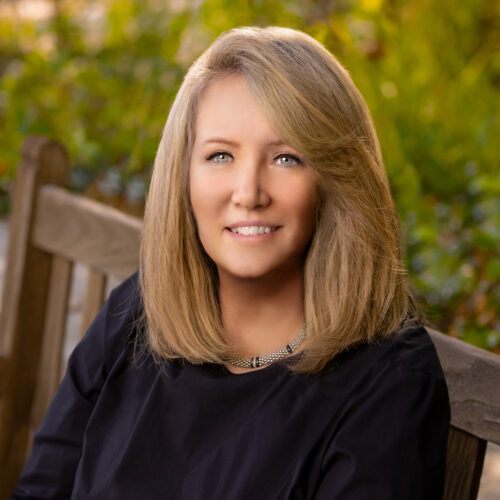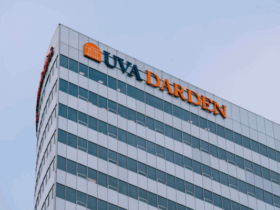Three things attract hundreds of millions of viewers to watch the Super Bowl every year: commercials, the halftime show and of course, football. Super Bowl 58, between the Kansas City Chiefs and the San Francisco 49ers, had an added draw, Taylor Swift.
With big stars on and off the field, there seemingly wasn’t a second of airtime that didn’t feature a celebrity.
The Darden Report accurately predicted the impact Swift had on this year’s Super Bowl. Her presence alone had more women tuning into the sport throughout the fall. Data from the Sports Business Journal shows that the 2023 NFL regular season had its best female viewership on record (dating back to 2000).
Kim Whitler, an expert in marketing strategy and brand management at the University of Virginia’s Darden School of Business, told The Darden Report that these record-setting numbers coming during a fall in which the Kelce-Swift relationship played out in public view was not a coincidence.

The media and consumer attention that the relationship is getting appear to be part of what is helping drive female viewership.
Although Swift was only on the screen for 54 seconds (less than 1% of the four-hour game), the “Swifties” were locked in, giving the NFL and its advertisers a golden opportunity to appeal to women through a time-honored tradition – Super Bowl commercials.
UVA Today caught up with Whitler to learn about the history of that dynamic, and what to expect from this year’s ads.
Q. What ways are you seeing a push toward Super Bowl ads becoming more female-friendly?

A. First, almost all of the teasers I’ve seen are on the “fun” and “lighthearted” side. I’ve only seen one serious teaser, and it is an ad combatting antisemitism which you would expect to be serious. Recent research from Ad Age and Axios asked consumers of different cohorts (Gen Z, Millennials, Gen X, Boomers) what “tone” they wanted in Super Bowl ads. Overwhelmingly, all of the different demos want “funny.” They want to be entertained. If the teasers are any indication, the focus on funny – versus purpose-driven or serious – should help drive enjoyment and entertainment.
Second, there appears to be more brands that are advertising this year that target women. NYX and E.L.F. – two makeup brands – are making their Super Bowl debuts. There are a number of chocolate and sweets brands that are advertising, including Lindt, Reese’s, M&M’s, Oreo and so forth.
Third, humor and heartwarming stories can resonate with women. Budweiser’s “Puppy Love” ad from 2014 was the top scoring ad from USA Today’s Ad Meter that year. With the high-profile challenges Bud Light (and Anheuser-Busch InBev) have had this year, they are bringing back the Clydesdales-dog pairing.
The Clydesdales are back in a Super Bowl commercial!
Handler Lane Soendker and a Clydesdale named Olaf join @reevewill to celebrate the return of the beloved horses and an exclusive first look at Budweiser’s 2024 Super Bowl LVIII ad! https://t.co/NCvz15wUru pic.twitter.com/M246bc3zh7
— Good Morning America (@GMA) January 31, 2024
Q. What do companies typically do to target women in Super Bowl ads?
A. There are different ways that companies can choose to connect with women – through the brand itself, the tone of the advertising, the message, the music, the talent and so forth.
For example, take the Lindt ad this year. The CEO, Ana Dominguez, indicated that their target is over 35. She didn’t indicate whether the target was male and/or female, but it is likely women because the ad’s protagonist is a woman and most of the cast is female.
The music in the ad is from Perry Como. This will speak directly to an older demographic group, although it tested well with younger people. The music was chosen to help provide a moment of “bliss” and cut through the chaos of the Super Bowl. Everything about the ad is designed to connect with mature women – from the tone, the message, the product, the brand, the music, the casting and so forth.
Q. What are some examples of women as protagonists in Super Bowl ads?
A. Let’s look at last year’s No. 1 and No. 2 Super Bowl ads, as voted by Americans through USA Today’s Ad Meter. The highest rated ad was for Farmer’s Dog – a heartwarming ad about the relationship between dog and a little girl (protagonist) that grow up together. At the end of the commercial, the following words appear: “Nothing matters more than more years together.”
The Farmer’s Dog ad captures the deep importance and authenticity of pet-parent relationships. For highly involved pet parents, the bond between a pet and parent can be similar to that of a mom and her baby. Capturing that bond – as Farmer’s Dog does – in a truly genuine and heartfelt manner can resonate with women as it honors the seriousness, specialness and depth of the relationship.
Last year’s second-highest rated ad was for the NFL and featured several female athletes and celebrities promoting women’s flag football. This ad worked because it hit on female empowerment, strength and growth of opportunity.
Q. What is another trend to watch with Super Bowl ads this year?
A. Almost all of the brands that have publicly announced that they are airing Super Bowl ads have teasers. A few years ago, we started seeing brands introduce teasers ahead of the Super Bowl. This year, it is pervasive. This is smart.
There is a lot of attention from the press before the Super Bowl about the ads. If you are spending $7 million on a 30-second ad and another $2 million for the ad itself (and who knows how much on the talent with all of the celebrities), companies should want as much awareness as possible – and free publicity ahead of the big game is a good idea.
Q. Which company is excelling with that strategy this year?
A. One very interesting approach this year is from the brand Drumstick, which enters Super Bowl advertising for the first time.
They are sharing a 5-minute short film with their announcement. Think about that – most companies run very short teasers (10 seconds) only designed to drive interest in the Super Bowl ads. A five-minute short film, if created in an effective manner, should drive greater engagement, knowledge and interest in the product.
It’s a smart way to take all the earned media that exists two weeks before the big game and drive deeper, longer engagement. What they are doing is thinking not just about the Super Bowl game, but the two weeks before and after and thinking about a bigger, more expanded content play. If I were still a practicing chief marketing officer, I would move in this direction.
This article originally appeared in UVA Today.





